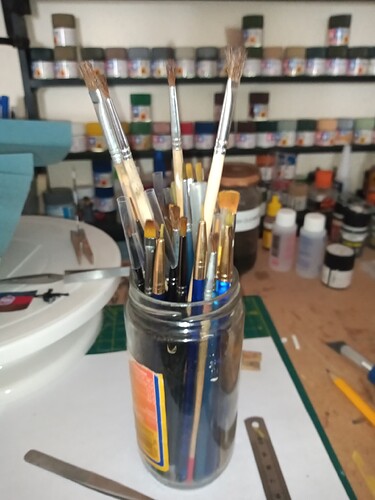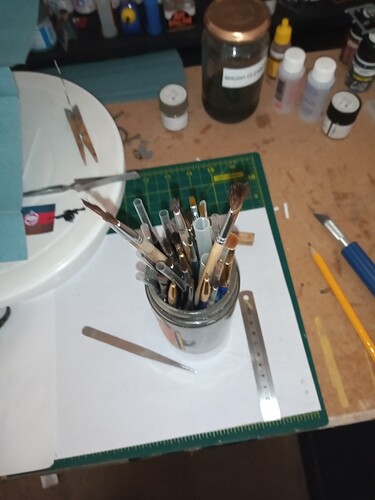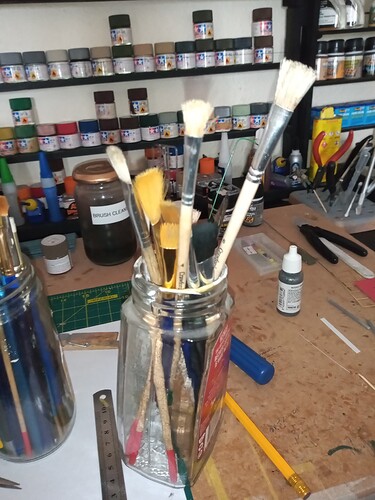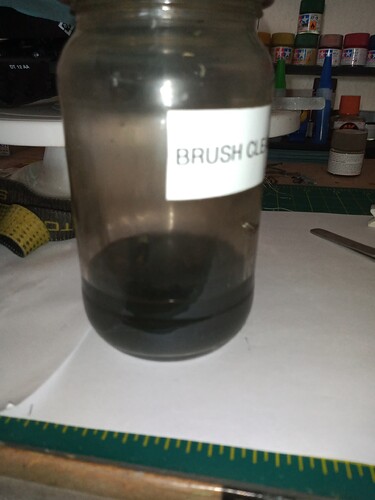I’ve been cleaning my brushes with tap water and then letting them dry, followed by placing them in a bag-type thing which a set of paintbrushes I bought came in. Is there a better way to store paintbrushes, or at least, what do you guys do? I recently bought some new smaller brushes, but am running out of space in the bag.
@RougePilot Try this…it works very nicely.
I keep it simple to match my mind, it’s almost a three-year degree course for some artists. Assuming the brushes are good/best quality (typically not the $2 kind – if they start shedding hairs almost immediately chuck ‘em) they repay good care – I have a couple of sables & a nylon equivalent that are still serviceable after more than 5 years of very regular use.
Never leave brushes standing in the water/solvent for more than a few minutes…ideally not at all. If you need to keep using a “loaded” brush several times in the same session tightly wrap it in cling-film/wrap when not in use. Whether oils or acrylics, after rinsing out as much paint as possible (without hammering the brush against the bottom of the fluid container) I squirt a blob of washing-up liquid into my palm and gently “paint” the brush in it for half a minute. Then rinse in tap water for half a minute, squeeze dry in a paper towel taking care to return the hairs to their original shape…and check there’s zero discolouration on the towel, otherwise repeat process. Allow to dry naturally. Store head-up in a box or cupboard where dust can’t settle. If they came with their own plastic collars use ‘em. Not sure about a bag, the brush(es) could get mis-shapen inside it if rubbing together. ![]()
For the thinnest brushes, never lose that plastic tube sleeve that comes at the end. Practically all good brushes have that clear plastic tube sleeve where you insert the bristles in. It prevents damage to the brush head. So once washed and dried, reinsert the brush head into that tube sleeve for storage.
God I am so bad… And such a complete slacker when it comes to paint brushes lol… Reading the above threads, I think I have broke every rule in the book concerning brush care ![]()
![]()
This is how I store them… 2 jars
There’s probably about 30 or so crammed in there lol…
I try and protect them but …the above ones are my daily users… The ones below are the big boys for Dio bases etc which really get abused lol
I treat all my brushes with the same total contempt and disregard lol…I don’t mean to…
I forget about them and let them stand in the cleaning jar for ages…
The cleaning jar from the black lagoon…
I seriously don’t know what fluids are in there at this stage
I leave them in there so long the ends fall off and I have to reattach them with super glue
They get cleaned with tap water, thinners, turps, white spirit, clean white spirit, you name it, I clean them with it.
Once out the jar or cleaned, I attack them with tissue paper, kitchen paper towel … They are rubbed, pulled twisted to within an inch of their short bristled lives… Bless them ![]()
In my defence, some of them in that jar are over 10 years old …
Just store them in a jar or cup, handle down - bristles up.
If you need to take brushes somewhere, best thing is to use the little plastic tubes that usually come over the bristles when new. Replace the tubes and carry flat in the top tray of something like a fishing tackle box.
For cleaning, there are proprietary brush cleaners and “restorers.” I use a combination of Winsor & Newton’s Brush Cleaner and The Masters Brush Cleaner and Restorer.
I first rinse the paint from the brush by swishing around in a jar of the appropriate thinners (water, mineral spirits, inexpensive isopropyl alcohol (rubbing alcohol from the pharmacy) or lacquer thinners). Avoid “bunging” the bristles on the bottom of the container.
Then I use the W&N cleaner to “deep clean” the bristles, especially at the ferrule. Use a rolling side pressure on a piece of toweling allowing the W&N cleaner to soak for a minute or two. (Note that the W&N cleaner will take the finish off of wooden handles, so only dip the bristles into it.) I do this until I don’t get any more color on the toweling.
I follow up the W&N deep cleaning with The Masters cleaner which requires adding water to the top of the “cake” of material, then rolling-swishing the bristles in it to work up a foam. Wipe this off against clean toweling to re-form the pointed tip and allow The Masters cleaner to dry in the bristles. Before using the next time, give the brush a swish in the clean thinners (doesn’t matter what kind) to rinse The Masters conditioner out and to also pre-load the bristles at the ferrule with thinners (which helps to mitigate the paint buildup in that hard to clean area).
A fair substitute for The Masters conditioner is ordinary hair washing conditioner. Mix up a bottle with something like 1:1 hair conditioner and water. After cleaning natural bristle brushes, put a few drops of this into the bristles, then reform the point by rolling and dragging the bristles across a clean towel. Again, store with the conditioner in the bristles, upright in a cup or jar.
Good brushes are expensive and worth the time and effort to maintain and care for them. I’ve had and still have sable brushes that are years and years old. Once they become worn out, they’re done for, but their life can be extended greatly with good cleaning and storage.
I forgot to mention that I need to be able to put my setup away in drawers, since I don’t have a dedicated desk for the hobby, and use my regular desk.
The good thing is after the brush is not up to speck anymore, you can use it to put on pigments and groundwork.
I have some older brushes that I use for armor texture and mud effects/groundwork.
I only use my Artbin brush boxes for my thin figure painting brushes, the one that have a candleflame pointed tip. I bought these brush sets from Europe and these are very thin sable brushes.
The cheap art store brushes I also store in a container upright as those can be replaced easily and I place the container in a large box to prevent bumping and moisture. Since I’ve abandoned AFV modeling some time ago, I rarely use those larger brushes now.
I advise that modelers rank their brushes and store and preserve the best, most expensive, and rarest ones in better containers for optimum condition. The rest, as other modelers have posted, can be stored upright in containers. The Artbin Brush Box is a great way of keeping track of your best brushes.
The Masters Brush Cleaner and Preserver works…not hype…and it will restore brushes and get their bristles to behave. It’s essentially brush soap…or think of it as Shampoo and Conditioner for hair.
How do you walk?
What do you mean?
“away in drawers”
Uuuuuuuuuhhhhhhhhhh…
Unless it’s a joke that I don’t get, that is how I roll, most of my stuff is either in a drawer or in boxes. I don’t have space for a full-time setup, so that’s what I do.
Drawers/underpants
Ah, I see now. As you can see, I am not British, so I don’t use that word.
It’s used on this side of the pond too. You ain’t from around here? Bless your heart.
No, it isn’t used here. Your area is the exception.





